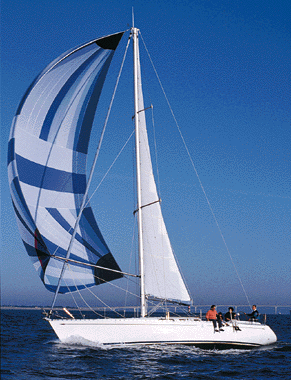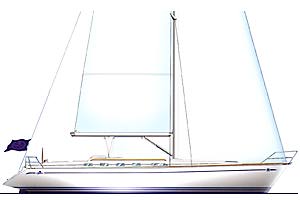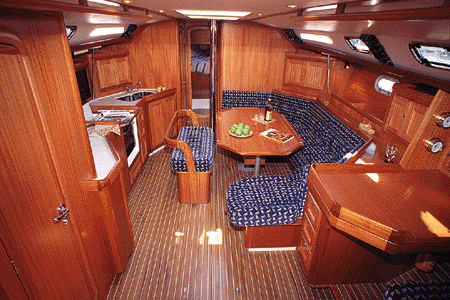
Photos courtesy Dufour USA
Dufour Classic 45
Seaworthy, well built, salty if you want, big
enough for Caribbean Charter service, well laid out . . . but no condo.
by Captain Thom Burns
The best and only way to review any boat is to sail it. The longer the better.
It is hard to get any better than sailing it for a week. This time of year I
must confirm your suspicion that it was a Caribbean charter. No company
representative or salesman aboard.
A Brief History
 |
| Dufour 45 Classic Photos courtesy Dufour USA |
Dufour has been building boats for 38 years. When the U.S. market went soft,
Dufour turned to high end niche market boats such as the Prestige 48 and 56
after leaving the U.S. market along with a host of other builders in the
eighties. They made a dramatic return to the U.S. market with the introduction
of the Dufour Classic 41 and 45 at the Annapolis Boat Show in 1988.
In 1994 Dufour developed the Nautitech Catamarans and acquired the Dynamique
yard. In 1995 they expanded the Classic line to several models ranging from 30
to 50 feet.
In 1996 the company took over Gibert Marine in Marans, France and became the
number two builder in France. Several internal modernization and consolidations
followed resulting in two plants in La Rochelle, France in 2000. The Gib’sea
line, less expensive, was introduced and has continued to expand.
Dufour Yachts USA is the company’s wholly owned subsidiary. There are now
several dealers throughout the U.S.
Design
Olivier Poncin and J & J Designs teamed up to design a voluminous hull with
ample accommodations for many in the charter trade, and for a family or three
couples for short hops. This is all packaged in a modern, moderately shallow
hull form with a moderate displacement of 24,250 lbs. It’s beamy at 14’1”.
Underwater there are two options, a 7’8” draft keel or a 6’ draft. We had the 6’
version. The rudder is balanced and utilizes a tight rack and pinion system.
| Concept: Olivier Poncin Architects: J & J Designs LOA: 45’11” Hull Length: 44’7” LWL: 37’5” Beam: 14’1” Draft: 6’/7’8” Displacement: 24,178 lbs Ballast: 8,690 lbs Engine: 60hp Sail Area: 1,270 sq. ft. Water: 120 gal Fuel (diesel): 58 gal CE Category: Cat. A |
The deck is clean and efficient. The primary winches are within easy reach of
the helmsman. The mainsheet, traveler, reefing controls and halyards are all on
the cabin top.
The cockpit is large with comfortable seating. The helm is comfortable and very
responsive. Our boat ran a 130 genoa on a roller furler, a full batten main with
lazy jacks and triple reef points. The mast is deck stepped which keeps the boat
dry. It also requires a mast compression post in the cabin and a reasonably
tuned rig. The rig is a double spreader standard sloop.
Below is bright with mahogany woodwork and white liners with several opening
ports and hatches. The galley to port is straight line style, European to us,
American to Europeans. It is a little different. It worked quite well for us
with the center island as a butt rest. The European model which we sailed had a
stock two burner stove rather than the three burner version standard for
American deliveries. I never missed the third burner until it wasn’t there. This
design style eliminates the settee to port which is my favorite sea berth on
most boats.
The standard layout is either a two cabin or three cabin. Ours was four cabin
for the charter trade. If I were to buy this used or for long distance I would
probably go with the three cabin version and appropriate one of the aft cabins
for extra storage and work space.
The Dufour 45 is powered by a 60 hp Volvo with a sail-drive unit. The handling
advantage of a saildrive unit is that the screw is farther from the rudder which
lowers prop wash. It also lessens but does not eliminate prop walk. The unit
also eliminates the prop shaft and its fittings. If the engine is mounted
properly, vibration should be minimized. The disadvantage of this system is the
opening in the hull is larger. I like this system and in combination with the
rack and pinion steering, the boat handles really well under power.
 |
Construction
 |
| This drawing represents the sleek, long lines of the Dufour Classic line. The Dufour 45 is a faster cruiser which goes to weather |
The hull is hand laid, cored with PVC foam and vacuum bagged. The deck is cored
with balsa. This process forms natural insulation without excess or uneven resin
distribution. An NPG, neo-pentylglycol resin gelcoat is used. It has a very low
porosity which should provide an excellent osmosis barrier.
The floors are laminated to the hull as are the bulkheads which also tab to the
deck. The heads and other modules are glassed into place.
This whole process produces a strong, light hull utilizing a combination of
modern new innovations and tried and true traditional building techniques such
as hand laying of the hull.
Performance
The Volvo 60 hp engine powers the boat around the marina without a problem even
in high winds. It also moves the boat at hull speed when motoring or motor
sailing. It is definitely not underpowered.
We sailed the boat in a wide range of conditions. I noticed right away that the
helm was very responsive, the boat slid right into a grove and tracked well. The
boat goes to wind well even with the shallower keel. It tacks and powers up
quickly. Off the wind, it is pretty fast. In eight to ten knots the boat speed
never dipped below 5.8 knots. In a little more wind we routinely ran 7.8 to 8.1
knots.
Sailing from Gorda Sound, BVI to Jost Van Dyke on the outside passage we were
reefed in four footers for several miles. The boat felt stable and cut through
the waves effortlessly.
 |
| The KHAYA mahogany joinery is exquisite throughout even after two years in the Caribbean charter fleet. |
When we put the waves on the quarter she galloped along with an easy helm and
surfed to ten knots a few times.
Conclusion
The Dufour 45 classic is a solidly built boat that meets the needs of several
types of owners. It sails and handles well. While it is not commodious below, it
is certainly roomy. I would certainly take this boat offshore. It would be a
good boat to purchase with the later thought of sailing long distances or doing
Caribbean or other warm winter destinations.
If I were to make it my private boat. It would be outfitted with the three
burner stove, refrigeration and freezer, and, probably a generator and water
maker. The key to these comments is that you have good basic value in a hull in
which all of that can be accomplished with relative ease. During that process I
would have a great boat to sail.
Captain Thom Burns publishes Northern Breezes and Sailing Breezes.
For more info: Dufour Yachts USA
Great Lakes Dealer:
Bay Breeze Yacht Charters
12935 West Bay Shore Drive
Suite 120
Traverse City, MI 49684
Phone: 231-941-9458
Fax: 231-941-9548
Email: baybreeze@bbyc.com
http://www.bbyc.com
Chartering & Sales of Dufour Yachts into Lake Michigan Fleet
All contents are copyright (c) 1998-2003 by Northern Breezes, Inc. All information contained within is deemed reliable but carries no guarantees. Reproduction of any part or whole of this publication in any form by mechanical or electronic means, including information retrieval is prohibited except by consent of the publisher.